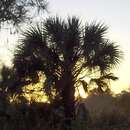More info for the terms:
cactus,
fern,
swamp,
tree,
xericIn southern Florida, cabbage palmetto is a common component of high and
low hammock, tree island, and mixed conifer-hardwood swamp communities
[
2,
3,
7,
9,
10,
13,
15]. Elsewhere it grows in more xeric scrub and Miami
rock-ridge inland communities [
4,
15]. In the Florida Panhandle,
Georgia, and South Carolina, cabbage palmetto grows within 12 miles (20
km) of the coast. It is a componenet of several diverse plant
communities, including those characteristic of dunes, salt flats,
barrier islands, and cactus thickets [
1].
Associates are many and varied because of the diversity of Florida's
flora and the ecological amplitude of cabbage palmetto. Overstory
associates include south Florida slash pine (Pinus elliottii var.
densa), slash pine (P. elliottii var. elliottii), pond pine (P.
serotina), loblolly pine (P. taeda), longleaf pine (P. palustris),
eastern redcedar (Juniperus virginiana), various evergreen oaks (Quercus
spp.), loblolly-bay (Gordonia lasianthus), red bay (Persea borbonia),
magnolia (Magnolia spp.), sweetgum (Liquidambar styraciflua), red maple
(Acer rubrum), baldcypress (Taxodium spp.), pignut hickory (Carya
glabra), gumbo-limbo (Bursera simaruba), and cocoplum (Chrysobalanus
icaco). Understory associates include gallberry (Ilex glabra),
huckleberries (Gaylussacia spp.), blueberries (Vaccinium spp.), lyonias
(Lyonia spp.), southern bayberry (Merica cerifera), holly (Ilex spp.),
saw-palmetto (Serenoa repens), greenbriar (Smilax spp.), bracken fern
(Pteridium spp.), poison-ivy (Toxicodendron radicans), bluestem
(Andropogon spp.), sawgrass (Cladium jamaicensis), and beak rush
(Rhynchospora spp.). Exotic associates and probable competitors include
casuarina (Casuarina spp.), melaleuca (Melaleuca quinquenervia), coconut
(Cocos nucifera), and Brazilian peppertree (Schinus terebinthifolia).

